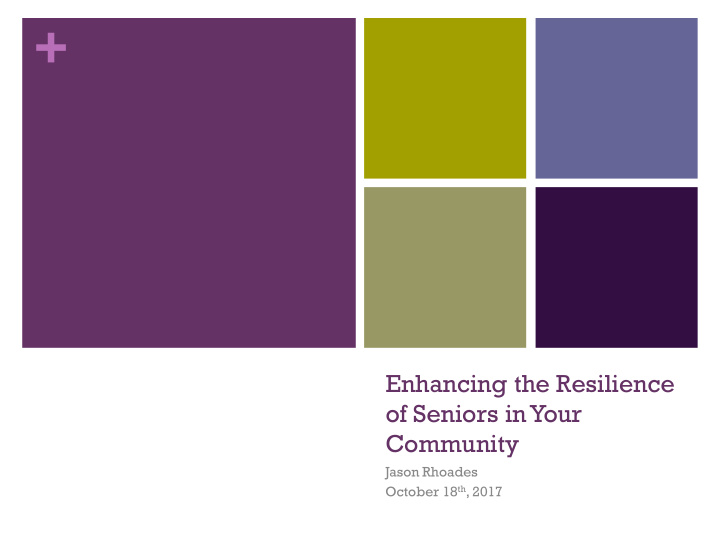



+ Enhancing the Resilience of Seniors in Your Community Jason Rhoades October 18 th , 2017
+ Outline Seniors and climate change Case Study: Climate Resilient Seniors Process Results (Vulnerability and Adaptation) Lessons Learned
+
+ Contributing Factors Physiological and cognitive impairments Economic limitations Social isolation
+ Seniors and Adaptation Planning Most in need of adaptation support Have first hand knowledge and experience to contribute May have less voice in adaptation planning Focus on “key stakeholders” Limited ability to engage Minority concerns Risk failing to address their needs and concerns
+ Participatory Adaptation Planning with Vulnerable Groups Engage seniors in dedicated process then bring to larger community Build understanding of issue and potential actions Set individual and collective priorities Find voice(s) Enhance capacity to self advocate Inform community efforts
+ Case study: Climate Resilient Seniors Socioeconomically diverse Multiple stressors Heat waves Air pollution Flooding Storms Sea level rise
+ Participatory Adaptation Process Step in Process Purpose* Initial planning meeting Identify current and future climate changes relevant to the community Consider resources, challenges, needs Design outreach and engagement 2 Vulnerability assessment meetings Assess vulnerability of the senior community Vulnerability survey Prioritize vulnerabilities to address 2 Adaptation planning meetings Develop and prioritize adaptation strategies *adapted from NRC (2010) Adapting to the Impacts of Climate Change . National Academic Press.
+ Initial Planning Meeting Attending City Staff (Bridgeport DOA and OEMHS) AUNE Researcher Support organizations Seniors Focus Review the landscape (resources, stressors, needs, opportunities) Design structure & outreach for project process and specific meetings
+ Vulnerability Meetings Promoted through senior centers 55 participants Kept demographic records
+ Vulnerability Meetings Starting point vulnerability analysis Initial presentation on historical climate trends Break out group discussions How you are currently impacted? What factors contribute to your vulnerability to those impacts? How do you prepare for, cope with, recover? Presentation on predicted trends Discussion How would predicted changes impact you?
+ Impacts
+ Vulnerability – Personal Characteristics
+ Vulnerability – Contextual Factors
+ Current Strategies
+ Potential Climate Change Impacts Previously unaffected become affected Previous coping strategies no longer sufficient Misperception of severity of climate risks Adaptive capacity overwhelmed
+ Survey
+ Survey Results
+ Adaptation Planning Meetings Review of results of survey Brief presentation on adaptation planning best practices Set adaptation goals Develop specific strategies Prioritize strategies based on impact and feasibility Share results with relevant support organizations
+ Adaptation Goals Encourage preparedness Provide effective warnings Provide seniors with resources for securing safe shelter. Provide transportation resources Provide resources to help seniors accomplish essential tasks Provide resources to aid seniors in the recovery process
+ Adaptation recommendations Emergency preparedness trainings Emergency preparedness informational materials Reverse 911 sign up drive Tailor warnings Tailor shelters Promote volunteer ridesharing Establish a telephone-based clearinghouse Tailoring the city’s ongoing efforts
+ Impact and Feasibility n=35 n=7
+ Benefits n=35 And… Recommendations have co-benefits Implementation by city Increased awareness among support agencies Increased communication between local partners Increased trust between older adults and support agencies
+ Design Considerations Lessons Learned Fostering Accessibility and Inclusivity Using an Iterative Process Generating Initial Actions Building Partnerships
+ Fostering Accessibility and Inclusivity Recognize diversity Accessibility of meetings and materials Multiple opportunities for engagement Connect issues with day-to-day concerns Maintaining a diversity of perspectives
+ Using an Iterative Process Build individual and collective understanding one step at a time Fully understand system before developing interventions
+ Generating Initial Action Build initial action into the project/research timeline Facilitates transition from planning to action Success can generate additional actions
+ Building Partnerships Complementary partnership between municipality and higher education Filling gaps in expertise and resources Collaborate with multiple organizations Produce information useful to local organizations
+ Conclusions Seniors are highly vulnerable Changes could overwhelm adaptive capacity Support services are key Including seniors as participants has multiple benefits Opportunity for meaningful inclusion, increasing understanding, and building resilience Benefits of collaboration between municipalities and higher education
+ Resources, support, collaboration Contact me jrhoades@antioch.edu Full description of research https://etd.ohiolink.edu/pg_10?0::NO:10:P10_ETD_SUBID:113828 Journal article on vulnerability https://academic.oup.com/gerontologist/article- abstract/doi/10.1093/geront/gnw167/2967601/Developing-an-In- depth-Understanding-of-Elderly?redirectedFrom=PDF
Recommend
More recommend